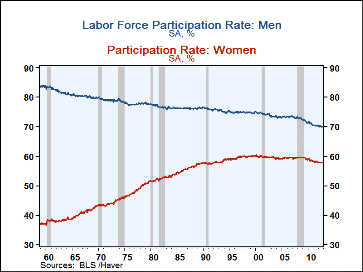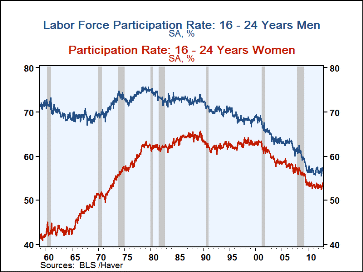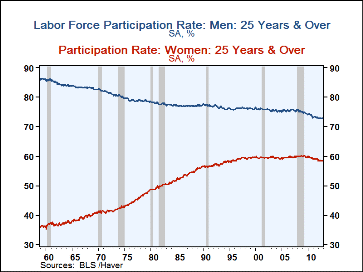 Global| Jan 07 2013
Global| Jan 07 2013U.S. Labor Force Participation Decline Is Sharpest For Men
by:Tom Moeller
|in:Economy in Brief
Summary
Participation rates in the labor force have been declining for decades. Friday's household employment report, from the Bureau of Labor Statistics, indicated that they reached new lows. December's 63.6% participation rate, which is the [...]
Participation rates in the labor force have been declining for decades. Friday's household employment report, from the Bureau of Labor Statistics, indicated that they reached new lows. December's 63.6% participation rate, which is the percentage of persons in the labor force versus the population, was down from its peak in the late-1990s of 67.1%. Detailed breakdowns of the rate indicate reduced participation across age brackets. However, the declines are greatest amongst men, young and old.There's no short answer to the question of why rates have declined precipitously. But a new study from the Federal Reserve Bank of Kansas City concludes that half of the decline is due to cyclical factors and half due to long-term trend influences.
For males, the latest participation rate of 70.0% was nearly the lowest after a decline from the early-1948 peak of 87.0%. The drop reflects a fall in the 25-year-old and over cohort to 72.7% from 89.2% in 1948. For those younger, the rate fell twenty percentage points during the same period to 56.6%. Working the other way, older men are staying in the labor force longer. For those aged 55 years and over the rate was 46.8% last year compared to a low of 37.7% in 1993.
In mirror image, the participation rate amongst women has surged since the mid-twentieth century. It peaked at 60.0% in 1999, up from 32.0% just after WWII. For women over 25, the rate now stands a 58.4%, double the rate in 1948. In contrast, the rate for younger women is up but just moderately. It now stands at 54.1% compared to 44.0% in 1948. Women are also staying in the labor force longer. For those aged 55 and older the rate was 35.3% last year versus just 22.0% in 1985.
The figures referenced above are available in Haver's USECON and EMPL databases.
Interpreting the Recent Decline in Labor Force Participation from the Federal Reserve Bank of Kansas City is availablehere.
| Civilian Labor Force Participation (%) | Dec | 2012 | 2002 | 1992 | 1982 | 1972 | 1962 |
|---|---|---|---|---|---|---|---|
| Total | 63.6 | 63.7 | 66.6 | 66.4 | 64.0 | 60.4 | 58.8 |
| Men | 70.0 | 70.2 | 74.1 | 75.8 | 76.7 | 78.9 | 82.0 |
| 16 to 24 | 56.6 | 56.5 | 65.5 | 70.4 | 72.6 | 71.2 | 70.0 |
| 25 and over | 72.7 | 72.9 | 75.9 | 77.0 | 77.8 | 81.3 | 84.6 |
| 35-44 | 90.3 | 90.7 | 92.1 | 93.7 | 95.3 | 96.3 | 97.6 |
| 45-54 | 85.6 | 86.0 | 88.5 | 90.7 | 91.3 | 93.2 | 95.6 |
| Women | 57.7 | 57.7 | 59.6 | 57.8 | 52.6 | 43.9 | 37.9 |
| 16 to 24 | 54.1 | 53.2 | 61.1 | 61.8 | 62.1 | 52.9 | 43.2 |
| 25 and over | 58.4 | 58.5 | 59.4 | 57.1 | 50.2 | 41.3 | 36.8 |
| 35-44 | 75.0 | 74.8 | 76.4 | 76.7 | 68.0 | 52.0 | 44.1 |
| 45-54 | 74.1 | 74.6 | 76.0 | 72.6 | 61.6 | 53.8 | 50.0 |
Tom Moeller
AuthorMore in Author Profile »Prior to joining Haver Analytics in 2000, Mr. Moeller worked as the Economist at Chancellor Capital Management from 1985 to 1999. There, he developed comprehensive economic forecasts and interpreted economic data for equity and fixed income portfolio managers. Also at Chancellor, Mr. Moeller worked as an equity analyst and was responsible for researching and rating companies in the economically sensitive automobile and housing industries for investment in Chancellor’s equity portfolio. Prior to joining Chancellor, Mr. Moeller was an Economist at Citibank from 1979 to 1984. He also analyzed pricing behavior in the metals industry for the Council on Wage and Price Stability in Washington, D.C. In 1999, Mr. Moeller received the award for most accurate forecast from the Forecasters' Club of New York. From 1990 to 1992 he was President of the New York Association for Business Economists. Mr. Moeller earned an M.B.A. in Finance from Fordham University, where he graduated in 1987. He holds a Bachelor of Arts in Economics from George Washington University.










